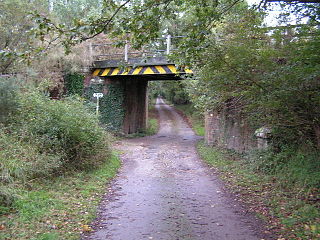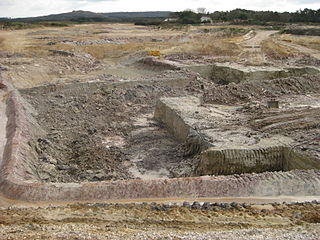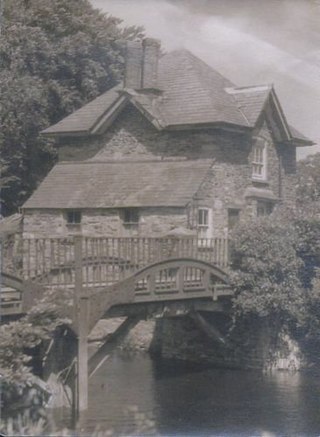
Corfe Castle is a village and civil parish in the English county of Dorset. It is the site of a ruined castle of the same name. The village and castle stand over a gap in the Purbeck Hills on the route between Wareham and Swanage. The village lies in the gap below the castle and is around four miles (6.4 km) south-east of Wareham, and four miles (6.4 km) north-northwest of Swanage. Both the main A351 road from Lytchett Minster to Swanage and the Swanage Railway thread their way through the gap and the village.

The Narrow Gauge Railway Museum is a purpose-built museum dedicated to narrow-gauge railways situated at the Tywyn Wharf station of the Talyllyn Railway in Tywyn, Gwynedd, Wales.

The Isle of Purbeck is a peninsula in Dorset, England. It is bordered by water on three sides: the English Channel to the south and east, where steep cliffs fall to the sea; and by the marshy lands of the River Frome and Poole Harbour to the north. Its western boundary is less well defined, with some medieval sources placing it at Flower's Barrow above Worbarrow Bay. John Hutchins, author of The History and Antiquities of the County of Dorset, defined Purbeck's western boundary as the Luckford Lake stream, which runs south from the Frome. According to writer and broadcaster Ralph Wightman, Purbeck "is only an island if you accept the barren heaths between Arish Mell and Wareham as cutting off this corner of Dorset as effectively as the sea." The most southerly point is St Alban's Head.

Purbeck was a local government district in Dorset, England. The district was named after the Isle of Purbeck, a peninsula that forms a large proportion of the district's area. However, it extended significantly further north and west than the traditional boundary of the Isle of Purbeck which is the River Frome. The district council was based in the town of Wareham, which is itself north of the Frome.

The Swanage Railway is a railway branch line from near Wareham, Dorset to Swanage, Dorset, England, opened in 1885 and now operated as a heritage railway.

Snailbeach District Railways was a British narrow gauge railway in Shropshire. It was built to carry lead ore from mines in the Stiperstones to Pontesbury where the ore was transshipped to the Great Western Railway's Minsterley branch line. Coal from the Pontesford coal mines travelled in the opposite direction. The line ended at Snailbeach, the location of Shropshire's largest and richest lead mine, though there had been a plan to extend it further, which would have brought it closer to more lead mines.
The Plynlimon and Hafan Tramway was a 2 ft 3 in gauge narrow gauge railway in Cardiganshire in Mid Wales. It ran from Llanfihangel station on the Cambrian Line, through the village of Tal-y-bont and the valley of the Afon Leri, into the foothills of Plynlimon Fawr. It was built to serve the lead mines at Bwlch Glas and stone quarries around Hafan and opened in 1897, closing just two years later. The line was a little over 7 miles (11 km) long and, despite running a short-lived passenger service, it served no communities of more than 100 people.

Swanage railway station is a railway station located in Swanage, on the Isle of Purbeck in the English county of Dorset. Originally the terminus of a London and South Western Railway (L&SWR) branch line from Wareham, the line and station were closed by British Rail in 1972. It has since reopened as a station on the Swanage Railway, a heritage railway that currently runs from Norden station just north of Corfe Castle to Swanage station. It now also runs to Wareham on certain services, but not on regular services due to signalling problems.

Herston Halt railway station is a railway station located at Herston near Swanage, on the Isle of Purbeck in the English county of Dorset. It is an intermediate station on the Swanage Railway, a heritage railway that currently operates from Swanage to Norden.

Corfe Castle railway station is a railway station located in the village of Corfe Castle, in the English county of Dorset. Originally an intermediate station on the London and South Western Railway (L&SWR) branch line from Wareham to Swanage, the line and station were closed by British Rail in 1972. It has since reopened as a station on the Swanage Railway, a heritage railway that runs regularly from Norden station just north of Corfe Castle to Swanage station. The line also connects Wareham and Norden.

Norden railway station is a railway station located one mile to the north of the village of Corfe Castle, on the Isle of Purbeck in the English county of Dorset. It is situated on the Swanage Railway, a heritage railway that operates over the former London and South Western Railway line from Wareham to Swanage. Norden is the northern terminus of the railway's steam service from Swanage, and an intermediate stop on the railway's diesel hauled service that connects Swanage with the national rail network at Wareham station.

The Furzebrook Railway, also known as the Pike Brothers' Tramway, was a narrow gauge industrial railway on the Isle of Purbeck in the English county of Dorset. It was built by the Pike Brothers, to take Purbeck Ball Clay from their clay pits near Furzebrook and West Creech to a wharf at Ridge on the River Frome.

Rail transport in Australia involves a number of narrow-gauge railways. In some states they formed the core statewide network, but in the others they were either a few government branch lines, or privately owned and operated branch lines, often for mining, logging or industrial use.
The Creekmoor Light Railway was a small, privately run, 2 ft narrow gauge railway. It was situated off Creekmoor Lane, to the north of Poole, between Broadstone and Fleetsbridge, Dorset, and was operated by a group of local enthusiasts from October 1968, to April 1973.

The Middlebere Plateway, or Middlebere Tramway, was a horse-drawn plateway on the Isle of Purbeck in the English county of Dorset. One of the first railways in southern England and the first in Dorset, the plateway was built by Benjamin Fayle, who was a wealthy Irish Merchant based in London and a friend of Thomas Byerley - Josiah Wedgwood's nephew. It was intended to take Purbeck Ball Clay from his pits near Corfe Castle to a wharf on Middlebere Creek in Poole Harbour, a distance of some 3.5 miles (5.6 km).

Purbeck Ball Clay is a concentration of ball clay found on the Isle of Purbeck in the English county of Dorset.

The Swanage Pier Tramway was a narrow gauge tramway in the port town of Swanage, in the English county of Dorset. It opened about 1858 and closed in the 1930s.

The Plymouth and Dartmoor Railway (P&DR) was a 4 ft 6 in gauge railway built to improve the economy of moorland areas around Princetown in Devon, England. Independent carriers operated horse-drawn wagons and paid the company a toll. It opened in 1823, and a number of short branches were built in the next few years.

Baulk road is the name given to a type of railway track or 'rail road' that is formed using rails carried on continuous timber bearings, as opposed to the more familiar 'cross-sleeper' track that uses closely spaced sleepers or ties to give intermittent support to stronger rails.

Furzebrook is a small village on the Isle of Purbeck, in the county of Dorset in the south of England. It is about 2 miles (3.2 km) south of Wareham and 2 miles (3.2 km) northwest of Corfe Castle, and is in the civil parish of Church Knowle.





















